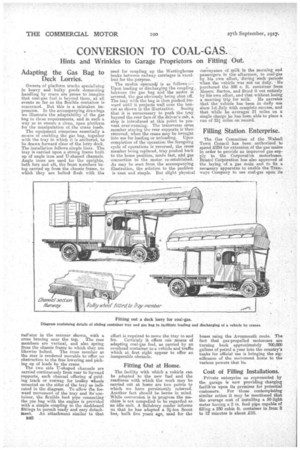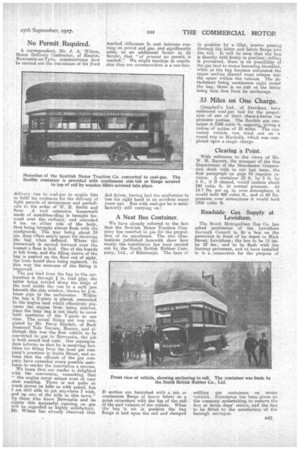CONVERSION TO COAL-GAS.
Page 12

Page 13

If you've noticed an error in this article please click here to report it so we can fix it.
Hints and Wrinkles to Garage Proprietors on Fitting Out.
Adapting the Gas Bag to Deck Lorries.
Owners of platform trucks specializing in heavy and • bulky goods demanding handling by crane are prone to imagine that coal-gas fuel is beyond them, at all events so fax as the flexible container is concerned. But this is a mistaken impression. In the accompanying drawings we illustrate the adaptability of the gas bag to these requirements, and in such a way as to ensure a clean, open platform for the manipulation ot the crane loads. The equipment comprises essentially a means of enabling the gas bag, together with the tray in which it is anchored, to be drawn forward clear of the lorry deck. The installation follows simple lines. The tray is carried upon a Strong frame built up of angle iron and U-shaped channels. Angle irons are used for the uprights, both fore and aft, the front members being carried up from the chassis frame, to which they are bolted flush with Om rad7ator in the manner shown, with a. cross bracing near the top. The rear members are vertical, and also spring from the chassis frame to which they are likewise bolted. The cross member at the rear is rendered movable to offer no obstruction to the free lowering and picking up of loads by the crane. The two side IT-shaped channels are carried continuously from rear to forward supports, each channel offering a? guid• ing track or runway for trolley wheels mounted on the sides of the tray as indicated in the diagram. To allow the forward movement of the tray and its`container, the flexible feed pipe connecting • the gas bag with the engine is provided ' with a simple coupling to the dashboard fittings to permit ready and easy detachment. An attachment similar to that
B40
used for coupling up the Westinghouse las•ake between railway carriages is excel lent. for the purpose. . . . The modus operamt,i is as follows Upon loading or discharging the coupling betWeen the gas bag and the niotor is severed, the gas obviously being shut off. The tray with the bag is then pushed forward until it projects well over the bonnet as shown in the illustration. Seeing that it is unnecessary to push the tray beyond the rear face of the driver's cab, a. stop is introduced at this point to prevent over-running. The transverse cross .member staying the rear supports is then removed, when the crane may be brought into use for loading or Unloading. Upon completion of the operation the foregoing cycle of operations is reversed, the cross member being replaced, tray pushed hack to the home position, made fast, afid gas connection to the motor re-established. As may be seen from the accompanying illustration, the solution to the problem is neat and simple. But slight physical effort is required to move the tray to and fro. Certainly it offers one means of adapting coal-gas fuel, as carried by an overhead container to a vehicle and traffic which at first sight appear to offer an insuperable obstacle.
The facility with vitiich a vehicle can be adapted to the new fuel and the readiness with which the work may be carried mit at home axe two points to which we have persistently referred. Another fact should be borne in mind. While conversion is in progress the machine is not compelled to be regarded as an idle unit. A Salisbury reader informs us that he has adapted a 2i-ton Scout bus, built five years ago, used for the
Fitting Out at Home.
conveyance of milk in the morning and 'ssertgers in the afternoon, to coal-gas by his owneffort, -during such periods when the velikle was not on duty. -Ple purchased the 500 c. ft. container from Messrs. Barton, and fitted it out entirely by his own effort, and that without losing. a morning 'trip for milk, lie narrates that the vehicle has been in daily use. since let July With complete Success, and that While he -averages 21 miles on a single charge he has been able to place a run of 23L. miles on record.
Filling Station, Enterprise.
The Gas Committee of the Walsall Town Council has been authorized to spend £254 for extension of the gas mains in order to provide an improved gas supply to the Corporation motorbuses. Bristol Corporation has also approved of the laying of a gas main and to fix a necoosary apparatus to enable the Tramways Company to use coal-gas upon its buses using the Avonmouth route. The fact that gas-propelled motorcars are turning back approximately 700,000 gallons of petrol a year into the country's tanks for official USES is bringing the significance of the movement home to the various powers that be,
Cost of Filling Installations.
• Private enterprise as represented by the garage is MOW providing charging facilities upon its premises for potential customers. For those contemplating similar action it may be mentioned that the average cost of installing a 50-light meter having a 2 in. feed pipe capable of filling a 250 cubic ft. container in from 8 to 12 minutes is about £10.
No Permit Required.
A correspondent, Mr. J. A. Wilson, Motor Delivery Contractor, of Heaton, Newcastle-on-Tyne, communicates how he carried out the conversion of his Ford
delivery van to coal-gas to enable him to fulfil his contracts for the delivery of light parcels of newspapers and Tieriodicats to the order of W. H. Smith and Sons. A roof extension framework made of matchboording is brought forward over the radiator, and extended 4 ins, on either side of the body, thus being brought almost flush with the mudguards. The tray being about 24 iris, deep offers ample space for receiving the bag when deflated. Where the framework is carried forward over the bonnet a floor is laid. One of the boards is left loose, and the filling sleeve of the bag is pushed on the floor out of sight, the loose board then being replaced. In this way the neatness of the fitting is improved.
The gas lead from the bag to the carburetter is through in. lead pipe, the latter being carried along the ledge of the roof inside the van to a cock just beneath the side window, thence by On. brass pipe to the carburetter, Within the bag a T-piece is placed, connected. to the engine lead which effectively prevents the engine from being starved, since the limp bag is not likely to cover both apertures of the T-piece at, one time. The actual fitting out was completed by Mr. Percy Sinclair, of Back Jesmond Vale Terrace, Heaton, and although this was the first vehicle to be converted to gas in Newcastle, the job is both sound and neat. Our correspondent informs us that he is receiving facilities for filling from the local gas company's premises in South Street, and relates that the officials of the gas company have extended every possible assistance to render the innovation a success.
We learn that our reader is delighted with the conversion, remarking that " the engine never misses even at very slow running. There is not quite so much power on hills as with petrol, but I am still able to get anywhere I wish, and up any of the hills in this town." To those who know Newcastle and its climbs this successful .running on gas will be regarded as highly satisfactory. Mr. Wilson has already observed that
parked .difference in cost between running on petrol and gas, and significantly adds, as an additional factor in its favohr, that "at present no permit is needed." We might mention in conclu sion that our correspondent is a one-lian .
ded driver, having had the misfortune to lose his right hand in an accident many years ago. But with coal-gas he is satisfactorily still carrying on!
A Neat Bus Container.
We have already referred to the fact that the Scottish Motor Traction Company has resorted to gas for the propulsion of its omnibuses. The two illustrations • published herewith show how neatly the installation ha a been carried out by the North British Rubber Company, 'Ltd., of Edinburgh. The bags of D section are furnished with a tab or continuous flange of heavy fabric at a point coincident with the top of the rail of the roof valance of the vehicle. When the bag is set in position the bag flange is laid upon the rail and clamped in position by a fillet, screws passing through the latter and fabric flange into the rail. It will be seen that the bag is thereby held firmly in position; rolling is prevented, there is no possibility of the gas feed to motor becoming throttled, while al; the bag becomes exhausted-the upper section thereof must relapse into the space within the valance. The attachment being continuous right round the bag, there is no risk of the latter being torn free from its anchorage.
33 Miles on One Charge.
Campbell's Ltd., of Aberdeen, have embraced coal-gas fuel for the propulsion of one of their chars-a,:banes for pleasure parties. The flexible gas container is 1000 cubic ft. capaciq, giving a radius of action of 33 miles. The converted vehicle was tried out on a round trip to Muehalla, which was completed upon a single charge.
Clearing a Point.
With reference to the views of Mr. W. M. Barrett, the manager of the Gas Department of the Manchester Corporation dealt with in our last issue, the first paragraph on page 69 requires revision. A container 12 ft. by 5 ft. by 5 ft., if D shaped, would contain about 240 cubic ft. at normal pressure. At 14.7 lbs. per sq. in, over atmosphere, it would hold 4130 cubic ft., and at -60 lbs. pressure over atmosphere it would hold 1200 cubic ft.
Roadside Gas Supply at Lewisham.
The South Metropolitan Gas Co. has asked permission of the Lewisham Borough Council to fit a box on the pavement, in front of its depot in High Street, Lewisham; the box to be 12 ins. by 18 ins., and to be flush with the footway pavement, and to have installed in it a connection for the purpose of
refilling gas containers on motor vehicles. Permission has been given on the company undertaking to remove the box at seven days' notice, and the box to be fitted to the satisfaction of the borough surveyor.






















